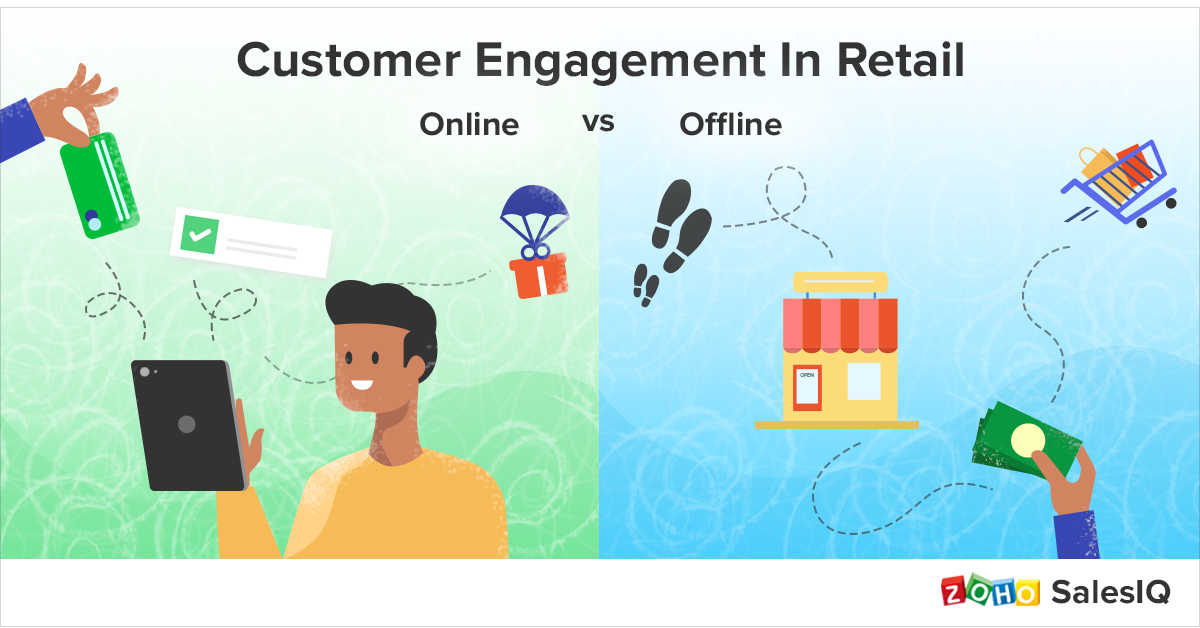
Engaging customers has always been a challenge for businesses, and that doesn’t look to be changing any time soon. The dynamic nature of consumer behavior and evolving technology has opened endless opportunities for businesses, but gaining a consumer’s attention can still be a monumental task.
We’ve moved into an era of digital automation and analytics, where everything happens in the blink of an eye and customers expect immediate solutions to their problems. They might order a product or a service online or at your store, but they expect a hassle-free experience either way.
From a business’ perspective, online and offline are two different channels, handled by people with differing skill-sets. Because of this, two customers who connect with the same business may have different experiences. Engaging with them in an equally satisfactory way, regardless of the platform, can be a challenge.
Changing Retail Landscape
The changing retail landscape has forced retailers to reinvent their customer experience strategies, both online and offline. Although e-commerce seems to be the future, it does not mean the end of brick and mortar stores. Let’s look at a few stats.
According to Total Retail Survey- 2017 conducted by PwC,
“It’s all about the customer: retailers are focusing investment on in-store experiences and social media campaigns while improving their ability to get a single view of the customer.”

According to Statista, by 2021, e-retail sales are expected to account for 15.5% of total retail sales worldwide. This calls for evaluating our priorities concerning customer experience across multiple brand touchpoints.
Amazon, and other traditionally digital brands, have invested in physical stores, which emphasizes the reality of a changing retail landscape. That change seems to be the adoption of an omnichannel approach, where the focus is to provide customers with a cohesive experience across all channels.
What Is Omni-Channel Retail?
Not long ago, marketers focused on optimizing individual channels without taking the whole experience into account. The omnichannel approach focuses on providing a consistent experience across any channels and devices that prospects might use to connect with a business.
Omni-channel retail, powered by a consistent customer experience, is revolutionizing the way individual channels pass information to customers. This is where marketing automation is playing its part and facilitating the flow of information between online and offline platforms. This not only reduces the friction in the buying process but also facilitates customer engagement.
Related Resources:
How to use technology to simplify hybrid retail customer experiences

Customer Engagement : Online vs Offline
Here’s how customer engagement differs online and offline. This will also give you an idea of what strategies companies are adopting to provide a more cohesive experience for their customers.
| Offline | Online |
Average response time | Immediate response, as there is a direct interaction | The average response time is 42 hours for companies that responded within 30 days. Companies are trying to reduce their average response time by:
|
Tangibility | Products are tangible | Products are not tangible. To overcome this, e-stores offer liberal return policies. |
Human Interaction | The salesperson is present to answer customer queries immediately | There is no human interaction, so companies usually choose to have live chat support online. |
Personalization | Sales personnel are present and able to cater to the customer’s needs. | A machine learning algorithm studies consumers’ choices and shows products or services they’re more likely to purchase. This information is also used to show more relevant offers to potential customers. |
Customer experience | Store layout and design | Site layout and design |
Factors Affecting Customer Engagement Across Channels
1. Average response time
While customers can expect an immediate response when they interact with brands in-store, a Harvard study captured data from 2,241 U.S. companies and found that when a customer made a query online:
- 37% responded within an hour
- 16% responded within 1-24 hours
- 24% took more than 24 hours
- 23% never responded at all
The average response time among companies that responded within 30 days was 42 hours.
2. Tangibility
Customer engagement is a grey box, and when the medium of interaction is online it adds to the complexity. Engaging with customers on platforms where products and services cannot be tried, tested, or sampled is a challenge for businesses. Tangibility is a major factor that can speed up the sales cycle for a business.
3. Human interaction
Even though we have e-stores, where customers don’t have to interact with a salesperson or a cashier, as they would in a physical store, most people need assistance when choosing from a vast pool of products and services available on a platform.
4. Customer experience with a brand
It is essential that customers have a consistent experience while interacting with a brand over different platforms and devices. It helps the company to establish trust, build its brand, and provide value to its customers.
5. Personalization
Personalization refers to customizing customer experiences throughout the sales cycle in order to reduce friction in the buying process. It is a key element if you’re looking for higher customer engagement. In the table above, we explain how companies are implementing personalization across different channels.
Now that we understand the factors that affect customer engagement on different platforms, we can conclude that having a holistic view of the buyer’s journey is the main factor in carving out a reliable customer engagement strategy.
Comments